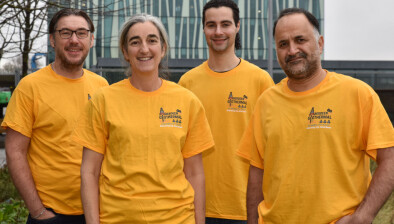And finally… Academics develop concrete using materials found on Mars
Students in America have developed a Martian concrete using materials naturally found on the planet.
Led by Gianluca Cusatis, the Northwestern University engineering team in Illinois said the high-strength concrete can be quickly created and is durable enough to withstand meteorite impacts — a key element needed to create viable shelters for humans on the Red Planet.
While typical concrete is made of gravel, cement, and water, the concrete developed by Cusatis, associate professor of civil and environmental engineering at Northwestern’s McCormick School of Engineering, comprises materials found on Mars. Instead of gravel, Cusatis used a Martian soil simulant created by NASA. And instead of water, he used molten sulfur, which is abundant on Mars.
The research is described in a paper recently submitted for peer review in the journal Construction and Building Materials. Lin Wan, a former PhD student in Cusatis’ laboratory, is first author of the paper. Former research associate Roman Wendner, who is currently working at the University of Natural Resources and Life Sciences (BOKU) in Vienna, Austria, is also an author on the paper.
Sulfur-based concrete is not a new idea. Highly corrosion-resistant, it is currently used in non-structural applications, such as pipes and landscaping. But because it is sensitive to heat and fire, it is rarely used for larger projects. After testing its mechanical properties, Cusastis found that his Martian concrete was more than two times stronger than typical sulfur-based concretes. In fact, after adjusted for gravity on Mars, its strength is equivalent to concrete used to build skyscrapers on Earth.
“You want buildings to be fire resistant, so that could be a vulnerability on Mars,” said Cusatis, a concrete expert. “But for the first settlements, fire won’t be the problem. The problems will be having secure shelters and durable buildings that can survive meteorite impacts.”

Cusatis said that his concrete’s strength is due to the small size of particles in the Martian soil as well as a little-understood chemical reaction between the soil and sulfur. His team also found that when the concrete breaks and is re-melted and re-casted, it becomes even stronger, which is most likely due to the additional reduction of the particle sizes.
“Typical sulfur concrete uses sand, which is inert. It’s just filler,” Cusatis said. “In our Martian concrete, the sulfur is not just glue. It reacts with the minerals in the Martian soil. That completely changes the picture.”
While conventional concrete requires 28 hours to develop full strength, Cusatis’ Martian concrete takes a mere one-to-two hours. For this reason, he thinks it’s a prime candidate for 3-D printing. If 3-D printers are sent to Mars, they could use local resources to print buildings made of Cusatis’ sturdy concrete. This would be much more efficient and sustainable than sending materials across the solar system from Earth.
Cusatis emphasizes that his concrete needs to be researched further. He is interested in learning more about the chemical reactions that make it so strong and wants to find ways to make it fire resistant. But with the first trip less than 10 years away, it’s not too soon to start preparing for the mission to Mars.
“People now seem serious about going to Mars,” he said. “Shelter is a big factor in those plans. Food and shelter are the two things that humans will need most.”
Contributions from SCN readers to our “And finally…” section are welcome – they should be sent to: newsdesk@scottishnews.com















